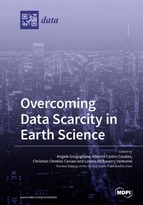Overcoming Data Scarcity in Earth Science
A special issue of Data (ISSN 2306-5729). This special issue belongs to the section "Spatial Data Science and Digital Earth".
Deadline for manuscript submissions: closed (31 August 2019) | Viewed by 36155
Special Issue Editors
Interests: surface hydrology; hydrologic and water-quality modeling; impact assessment of land use and climate change; urban hydrology and water-quality
Special Issues, Collections and Topics in MDPI journals
Interests: optical network; optimization; machine learning
Interests: water resources management; surface hydrology; flood modeling
Special Issue Information
Dear Colleagues,
Environmental mathematical models represent one of the key aids for scientists to forecast, create, and evaluate complex scenarios. These models heavily rely on the data collected by direct field observations. However, a functional and comprehensive dataset of any environmental variable is hard to collect, mainly because of: i) the high cost of the monitoring campaigns; and ii) the low reliability in the measurements (e.g., due to occurrences of equipment malfunctions and/or issues related to the equipment location). The lack of a sufficient amount of Earth science data may induce an inadequate representation of the response’s complexity in any environmental system to any type of input/change, both natural and human-induced. In such a case, before undertaking expensive studies to gather and analyze additional data, it is reasonable to first understand what enhancement in estimates of system performance would result if all the available data could be well exploited.
Missing data imputation is an important task in cases where it is crucial to use all available data and not discard records with missing values. Different approaches are available to deal with missing data. Traditional statistical data completion methods are used in different domains to deal with single and multiple imputation problem. More recently, machine learning techniques as clustering and classification, have been proposed to complete missing data.
This Special Issue on “Overcoming Data Scarcity in Earth Science” of the Journal Data is designed to draw attention to the body of knowledge that aims at improving the capacity of exploiting the available data to better represent, understand, predict, and manage the behavior of environmental systems at all practical scales.
Authors are encouraged to submit research articles, reviews, and short communications addressing this theme in this Special Issue.
Dr. Angela Gorgoglione
Dr. Alberto Castro Casales
Dr. Christian Chreties Ceriani
Dr. Lorena Etcheverry Venturini
Guest Editors
Manuscript Submission Information
Manuscripts should be submitted online at www.mdpi.com by registering and logging in to this website. Once you are registered, click here to go to the submission form. Manuscripts can be submitted until the deadline. All submissions that pass pre-check are peer-reviewed. Accepted papers will be published continuously in the journal (as soon as accepted) and will be listed together on the special issue website. Research articles, review articles as well as short communications are invited. For planned papers, a title and short abstract (about 100 words) can be sent to the Editorial Office for announcement on this website.
Submitted manuscripts should not have been published previously, nor be under consideration for publication elsewhere (except conference proceedings papers). All manuscripts are thoroughly refereed through a single-blind peer-review process. A guide for authors and other relevant information for submission of manuscripts is available on the Instructions for Authors page. Data is an international peer-reviewed open access monthly journal published by MDPI.
Please visit the Instructions for Authors page before submitting a manuscript. The Article Processing Charge (APC) for publication in this open access journal is 1600 CHF (Swiss Francs). Submitted papers should be well formatted and use good English. Authors may use MDPI's English editing service prior to publication or during author revisions.
Keywords
- Earth science data
- Data scarcity
- Missing data
- Data quality
- Data Imputation
- Statistical Methods
- Machine learning
- Environmental modeling
- Environmental observations







